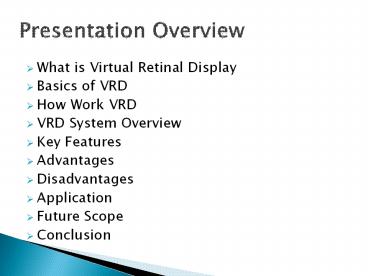What is Virtual Retinal Display - PowerPoint PPT Presentation
Title:
What is Virtual Retinal Display
Description:
What is Virtual Retinal Display Basics of VRD How Work VRD VRD System Overview Key Features Advantages Disadvantages Application Future Scope Conclusion – PowerPoint PPT presentation
Number of Views:2599
Avg rating:3.0/5.0
Title: What is Virtual Retinal Display
1
Presentation Overview
- What is Virtual Retinal Display
- Basics of VRD
- How Work VRD
- VRD System Overview
- Key Features
- Advantages
- Disadvantages
- Application
- Future Scope
- Conclusion
2
What is Virtual Retinal Display?
- PDD under development in HIT lab, University
of Washington. - Not a screen based technology.
- Scans light directly on to retina of eye.
- Full color, high resolution, high brightness,
wide field of view virtual display without
flickering. - Potential applications include HMDs for military,
aerospace, engineering, medical - fields.
3
Basics of VRD
- Substitute to conventional bulky and power
- hungry VDUs.
- Light is focused to a miniscule image(frame)
- on retina.
- SLD or LED triads of R,GB emits light.
- Mixing in proportions can produce any
- colour.
- As light scans the retina, it is intensity
- modulated by the video signal.
- Scanning is performed directly onto retina in
- a raster pattern through collimating optics.
4
continue
Above figure is the basic block diagram of VRD
5
continue
As shown, the viewer perceives a wide field of
view image as if from a screen placed some
distance away.
6
How Work VRD
- Very small and light weight glasses mountable.
- Large field of view, greater than 120 degrees.
- High resolution, approaching that of human
vision. - Full color with better color resolution than
standard displays.
7
continue
- Brightness sufficient for outdoor use.
- Very low power consumption.
- True stereo display with depth modulation.
- Capable of fully inclusive or see through display
modes
8
VRD System Overview
A block diagram of a VRD system is shown below
9
Key features
- Size and Weight Small size as no intermediate
screen is present. All components are small and
light making it highly portable. Appropriate for
Hand held and Head mount displays. - Power consumption Light sources consume very
less power in order of milli watts. Scanning is
done with a resonant device (MRS) with high
figure of merit. Exit pupil of VRD has very small
aperture allowing generated light to enter eyes
almost completely. Hence high power efficiency.
10
continue
- Resolution Limited only by diffraction and
optical aberration in the optical components,
limits in scanning frequency and modulation b/w
of photon source. SLD is a coherent source and
offer high modulation b/w to give resolutions
well over a million pixels. State of the art
scanners can scan over a1000 lines per frame
which is comparable to HDTV.
11
Advantages
- resolution
- luminance
- modes of viewing
- contrast ratio
- depth of focus
- power consumption
- Cost
- range of applications.
12
Disadvantages
- The disadvantage of these systems was the limited
area covered by the screen. - The high weight of the small televisions used to
project the display. - The fact that the image would appear focused only
if the user was focusing at a particular depth. - Limited brightness made them useful only in
indoor settings as well.
13
Application
- The various fields of application of VRD
technology are listed. - Radiology
- Surgery
- Therapeutics (Scanning Laser
Ophthalmoscope) - Production
- Communication
- Augmented \ Virtual reality
- Aerospace
- Military
14
Future Scope
- When cost of production falls further, we will
see VRDs fulfilling many functions and
applications, and may perhaps see a time where
they become ubiquitous in the more distant
future. - Future systems will be even more compact with the
advent of MEMS(Micro Electro Mechanical System)
scanners, miniature laser diodes and application
specific IC technology.
15
Conclusion
- VRD provides an unprecedented way to stream
photons to the receptors of the eye affording
higher resolution ,increased luminance, and
potentially a wider field of view than all
previous displays. Virtual retinal display is a
break through in imaging technology that will
optimally couple human vision to the computer.
16
- THANK YOU
17
- QUESTIONS?































